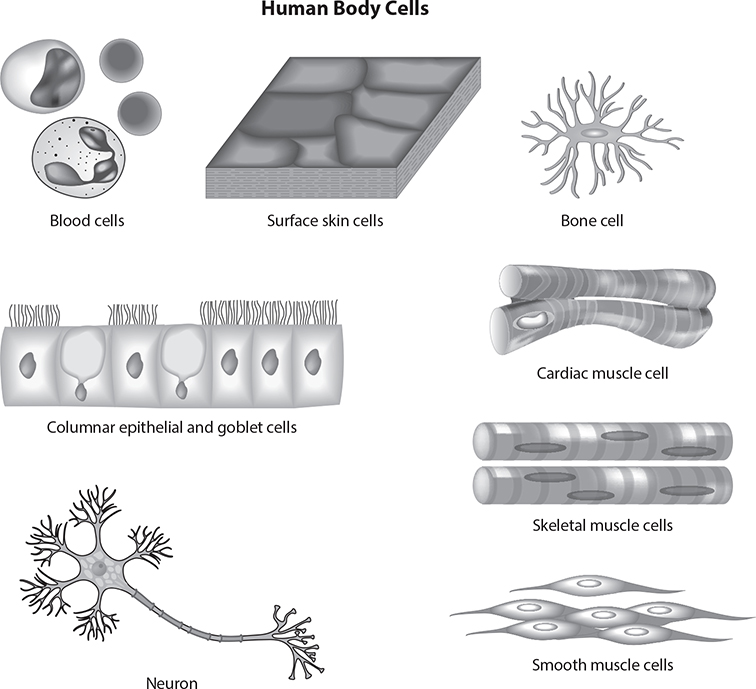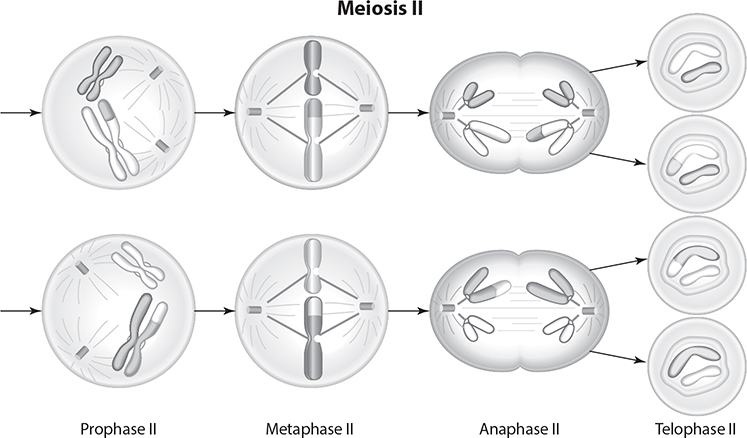CHAPTER 1
Structures and Functions of Life
Cells, Tissues, and Organs
The cell theory explains the relationship between cells and living things. It has three components:
• All living things are made of one or more cells.
• Cells are the smallest unit of structure and function in all living things.
• New cells can only be produced from other cells.
These ideas might seem like common sense today, but until the late 1500s, people had no way of knowing that cells existed. When the first microscope was invented around 1590, scientists started examining what living things are made of. By the 1800s, scientists had learned enough about cells to formulate the cell theory.
Specialized Cells
The following diagram shows just a few of the different types of cells in your body. Look at how different the cells’ structures are. Each cell’s structure helps it to carry out a unique function within the body. Muscle cells, for example, must be able to contract so the body can move. Nerve cells (neurons) have long appendages for transmitting signals throughout the body. Each type of cell is specialized for a particular job.

A group of specialized cells working together make up a specialized tissue. The following diagram shows four major types of specialized tissues. Connective tissue protects and connects other body tissues to one another. Bone, cartilage, and blood are connective tissues. Epithelial tissue covers and protects the surface of the body and the organs. Skin is an epithelial tissue.

Levels of Organization
Your heart, blood vessels, and blood are all part of your body’s cardiovascular system. These different parts work together to move needed substances throughout your body. Your body is also made up of several other organ systems, each with a unique job. Just like the cardiovascular system, each organ system is made up of several different organs working together.
An organ is composed of a group of tissues working together. Your heart is an organ made of cardiac muscle tissue. Remember that a tissue is composed of a group of specialized cells working together. Your heart tissue is made of cardiac muscle cells. Cardiac muscle cells contract together to make your heart beat.
The following diagram shows the different levels of organization in your body.

EXERCISE 1
Cells, Tissues, and Organs
Directions: Choose the best answer for each of the following items.
1. Which statement is supported by the cell theory?
A. A single cell is not considered a living thing.
B. Anything that has cells is considered a living thing.
C. All living things are made of the same types of cells.
D. A living thing can absorb new cells from the environment.
2. Complete the statement with a term from the section.
A bone cell is ____________________ to perform the unique function of storing minerals for the body.
Answers are on page 657.
Cell Functions and Components
Different types of cells are specialized for different functions in your body. All cells, however, do have certain functions in common. For example, all cells must be able to carry out a certain set of chemical reactions. Metabolism is the name for the set of chemical reactions that use the energy from food to build substances the cell needs.
Metabolism occurs in two parts. First, a series of reactions extract energy from food molecules and convert it to a form of energy that the cell can use. Then, a second series of reactions uses that energy to fuel processes like building proteins.
Reproduction is also a necessary function for all cells. Cells reproduce by a process called cell division. In this process, the “parent” cell divides into two identical “daughter” cells. We will look at this process in more detail later.
Cell Components
The following diagram represents a typical animal cell.

Just as different cell types have unique functions, the different components of a cell also have unique functions. This table lists the functions of some of the most important cell components.

Enzymes are also important molecules found inside cells. Enzymes are proteins that help chemical reactions to occur faster. Without enzymes, a cell would not be able to produce needed substances fast enough.
EXERCISE 2
Cell Functions and Components
Directions: Choose the best answer for each of the following items.
1. Which of the following is NOT a function performed by all cells?
A. reproducing
B. producing food
C. building proteins
D. converting energy
2. Complete the statement with a term from the section.
A cell cannot survive without mitochondria, because it would have no source of ____________________ to run cell processes.
Answers are on page 657.
Cell Division
A cell reproduces by a process called cell division. Cell division occurs in three stages. First, the cell’s nucleus makes an extra copy of its deoxyribonucleic acid (DNA) molecules, which carry the genetic instructions for forming new cells. Then the nucleus divides into two parts, each containing an identical copy of the DNA. Finally, the “parent” cell divides into two identical “daughter” cells.
Mitosis
Mitosis is the name for the second stage of cell division, when the cell’s nucleus divides in two. Mitosis occurs in four predictable phases, each of which is described in the following table. Remember that the cell starts mitosis with two copies of the DNA, and ends mitosis as two identical cells, each containing one copy of the DNA.

Meiosis
Meiosis is a special type of cell division that produces reproductive cells. You probably know that reproductive cells (eggs and sperm) unite to produce the first body cell of a new organism. Reproductive cells have half the number of chromosomes found in a regular body cell, so they must be made by a special process.
Meiosis occurs in two stages: meiosis I and meiosis II. Both stages are described in the following list. As in mitosis, the cell makes a copy of its DNA before starting meiosis. You’ll notice that the steps of meiosis are similar to the steps of mitosis, but with a few important changes.

• Prophase I. DNA condenses into structures called chromosomes and the nucleus disappears. Matching pairs of chromosomes trade segments in a process called crossing over. (We’ll discuss chromosomes in more detail and the importance of crossing over in a later section.)
• Metaphase I. Chromosomes line up in matching pairs.
• Anaphase I. One chromosome from each pair moves to the opposite side of the cell.
• Telophase I. The cell splits in two.

• Prophase II. Two cells have the same number of chromosomes as the original. Unlike prophase I, during this phase there is no new replication of DNA.
• Metaphase II. Individual chromosomes line up in each cell.
• Anaphase II. Chromosomes split into chromatids. Chromatids move to opposite sides of the cell.
• Telophase II. A nucleus reforms around each set of chromatids. Each cell splits in two again.
Notice that the final result of meiosis is four reproductive cells, each with half the DNA of a regular body cell.
EXERCISE 3
Cell Division
Directions: Choose the best answer for each of the following items.
Question 1 is based on the following diagram.

1. A student creates the drawing shown as he observes mitosis in onion root cells under a microscope.
Place a circle on the diagram to indicate the cell that appears to be transitioning from metaphase to anaphase.
2. Indicate your answer choice by connecting the correct process(es) to each description. Each process may be used more than once.

Answers are on page 657.